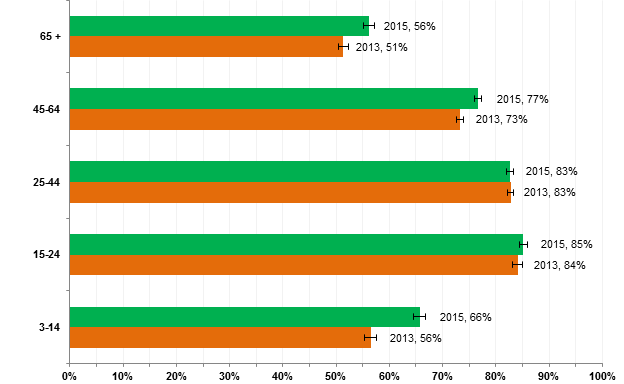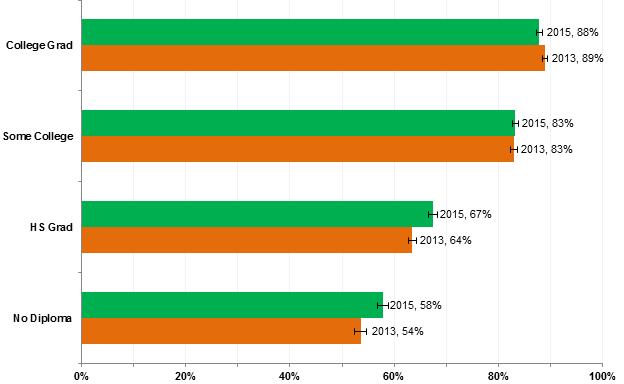First Look: Internet Use in 2015
As the Obama Administration continues to focus on expanding broadband access and adoption, NTIA released new data today that shows that some of the demographic groups that have historically lagged behind in using the Internet—such as senior citizens, minorities, and Americans with lower levels of educational attainment—are making big strides.
Particularly promising, Internet use increased significantly among children and older Americans between 2013 and 2015. Children between the ages of 3 and 14 became substantially more likely to go online, as Internet use among this group increased from 56 percent in 2013 to 66 percent in 2015, and Internet use among those aged 65 or older increased from 51 percent to 56 percent during the same period. In contrast, usage remained largely unchanged among those who were previously most likely to go online, with 83 percent of Americans between the ages of 25 and 44 reporting Internet use in both 2013 and 2015.
The latest data comes from the Computer and Internet Use Supplement to the Current Population Survey (CPS), which included nearly 53,000 households and was conducted for NTIA by the U.S. Census Bureau in July 2015. The large sample size provides a detailed picture of where, why and how Americans go online.
During most of our first 20 years of computer and Internet use research, NTIA focused primarily on which households had Internet connections at home. We began asking households whether they had dial-up Internet connections at home in 1998, and added different types of broadband technologies starting in 2000. Today, only a small fraction of online households (about 400,000) rely on dial-up Internet connections. Our 2015 data shows that home Internet use among households, which includes both broadband and the small number of dial-up users, remained virtually flat in 2015 at 73 percent compared with 74 percent of households in 2013. Internet use has become much more of an individual activity in recent years, thanks to the spread of smartphones, mobile broadband, Wi-Fi, and a general proliferation of devices and connectivity. Accordingly, NTIA is now focusing primarily on Internet use among individual Americans from a range of locations—not just in their homes.
In this latest edition of our long-running series of surveys, we asked dozens of questions about who goes online, where they do so, what devices, technologies, and applications they use, and what barriers stand in the way of all Americans realizing the Internet’s full potential. We continued tracking long-running trends that shed light on Americans’ shifting usage habits and the digital divide. In addition, we gathered new data on a range of contemporary issues, from the use of wearables and connected household equipment to concerns about online privacy and security.
Over the coming months, our team at NTIA will continue analyzing this latest dataset and publishing our results here on the Digital Nation Blog. We also encourage researchers and the public at large to dive into the latest data. Our Data Explorer tool now includes metrics from 2015, and we will soon post the public use dataset and sample statistical code in the Research Center.
Internet Use Increases Among Lagging Groups
Seventy-five percent of Americans (ages 3 and older) used the Internet from any location in 2015, up from 71 percent in 2013. As in previous years, Internet use continued to vary substantially based on age, with young and middle-aged adults going online at a higher rate than children and older Americans. For example, 85 percent of those between the ages of 15 and 24 went online in 2015, while adoption rates were lower among older and younger age groups. However, Internet usage rates were little-changed among relatively young adults, while they increased significantly for children and seniors (see Figure 1).
Figure 1: Internet Use by Age Group, Percent of Americans, 2013-2015

Along with increased use among the oldest and youngest Americans, the latest data suggests a slowly shrinking digital divide along other demographic lines, including educational attainment. While Internet use among those Americans with at least some post-secondary education remained steady between 2013 and 2015, it increased significantly among those with education up to a high school diploma. Although those with lower levels of educational attainment are gradually increasing their online presence, the gap in Internet use based on education remains quite large, with 88 percent of college graduates going online in 2015, compared with 58 percent of those with no high school diploma (see Figure 2).
Figure 2: Internet Use by Educational Attainment, Percent of Americans Ages 15+, 2013-2015

Internet use also grew more rapidly among African Americans (to 68 percent in 2015 from 64 percent in 2013), Hispanics (66 percent from 61 percent), and American Indians and Alaska Natives (70 percent from 61 percent), compared with Whites (78 percent from 75 percent) and Asian Americans (77 percent from 75 percent).
Taken together, these findings suggest that Internet use may be nearing a plateau among segments of the population that have historically been more likely to go online, and that efforts to further boost adoption in the United States should target the particular challenges faced by those who have been less likely to use the Internet. At the same time, how Americans access the Internet is clearly changing, a subject we will explore more closely in our next blog post. Our latest data shows a continuance of the shift toward mobile devices that we previously observed, which is enabling a new range of applications and options for getting online.
Want to learn more? We are hard at work preparing more reports in our series on the 2015 survey results. In the meantime, you can sign up for our Data Central mailing list to receive the latest news in your inbox.
